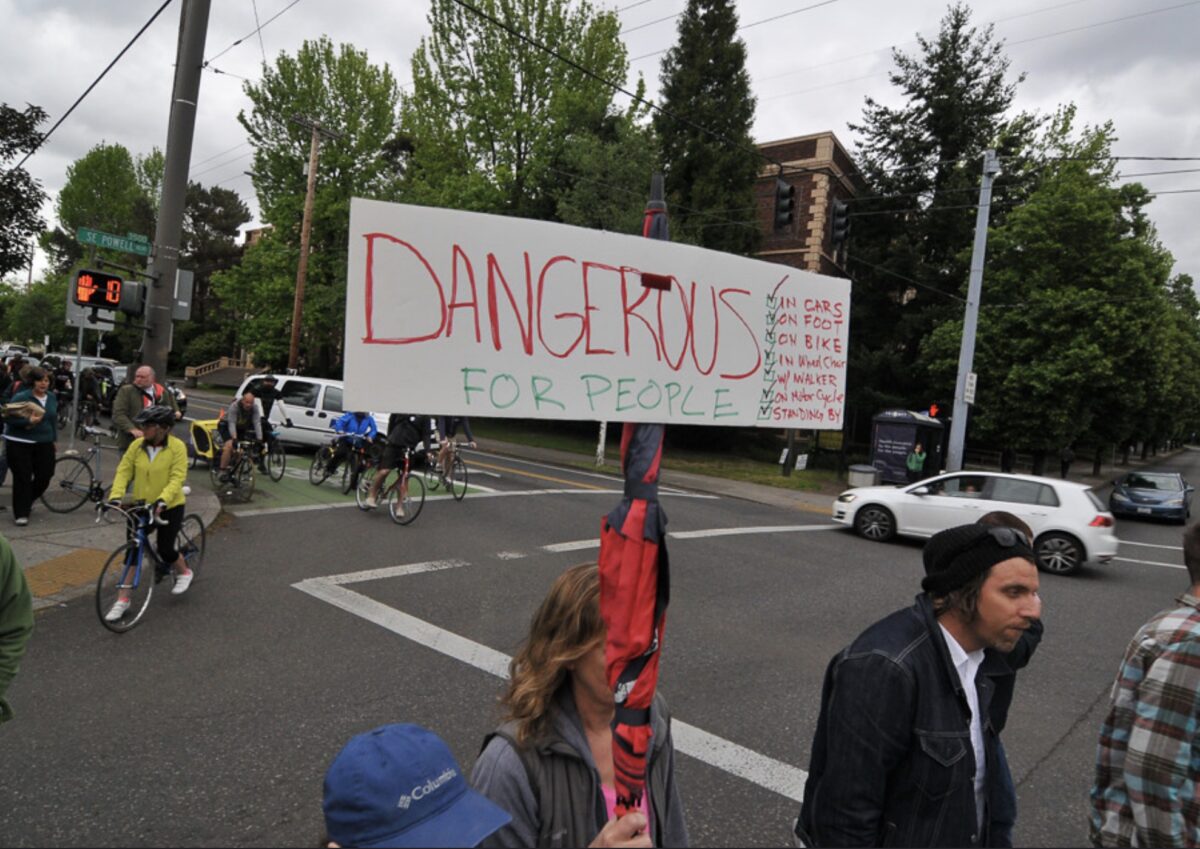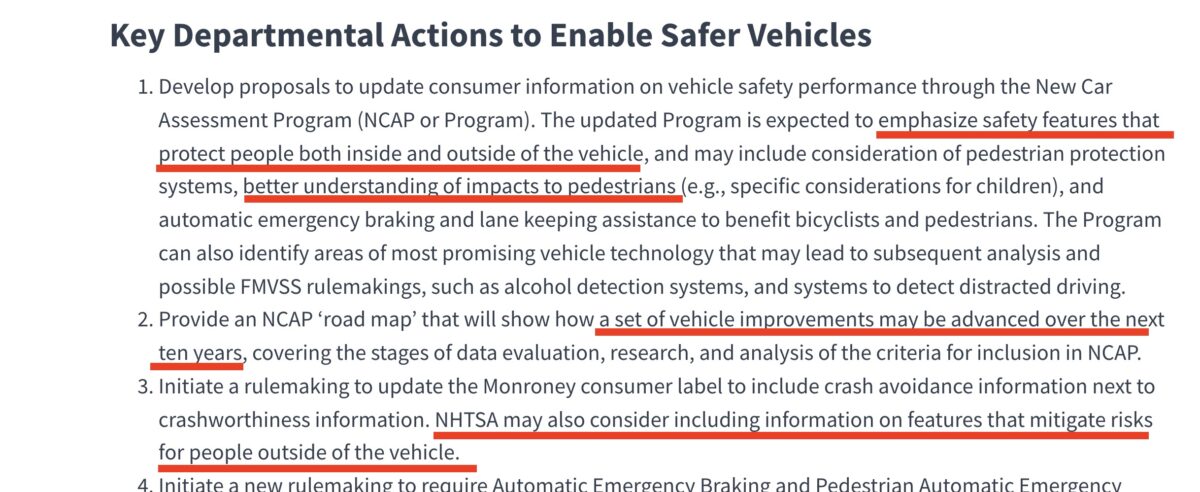
(Photo: Jonathan Maus/BikePortland)
“Technology alone will not save us. We need a national change in mentality.”
— Pete Buttigieg, U.S. DOT Secretary
Calling the mass injuries and loss of life on American roads a “national crisis”, on Thursday U.S. Department of Transportation Secretary Pete Buttigieg unveiled the National Roadway Safety Strategy (NRSS). It’s an unprecedented step from the federal government to coordinate a systemic response to the epidemic of traffic deaths and destruction.
In the lobby of DOT headquarters in Washington D.C., following an introduction by Second Gentleman Douglas Emhoff, Buttigieg said, “If you think about the fact that every one of us can think of people lost and speak of it as a sadly universal truth, it is as if we were living through war. It is as if it were normal… We cannot and must not accept that these fatalities are an inevitable part of life in America.”
For Sec. Buttigieg, the NRSS is the first step toward the goal of reaching zero roadway fatalities. He compared the upcoming new regulations and cultural shifts to how the federal government tackled food and workplace safety. “The decision to commit to [zero fatalities] in a serious way at a national level,” Buttigieg said, “Changes the way cities and towns design roads. It changes the ways companies build cars. It changes the way people drive.”

(Source: NRSS)
The NRSS itself is a 42-page plan that not only outlines the multi-layered strategy but gives us a look at national crash statistics. A map showing a state-by-state fatality rate per 100 million miles driven shows Oregon with 1.37, the highest rate on the west coast and among the top 25% deadliest in the country. The plan also centers how the lack of safety on our roads unfairly impacts people with lower-incomes, Black people and other communities of color, as well as the most vulnerable road users like bicycle riders, walkers, and transit users.
Advertisement
The plan draws a direct line between increasing deaths to walkers and bikers in the past decade to America’s effort to tackle climate change. Dangerous roads have, “… a chilling effect on
climate-friendly transportation options such as walking, biking, or taking public transportation,” it reads. And we must have safer roads, “To unlock the climate benefits of those modes.”
There are five specific categories where NRSS will focus, and each of them reveals how the DOT under Buttigieg plans to approach this massive problem:
• Safer People: Encourage safe, responsible behavior by people who use our roads and create conditions that prioritize their ability to reach their destination unharmed.
• Safer Roads: Design roadway environments to mitigate human mistakes and account for injury tolerances, to encourage safer behaviors, and to facilitate safe travel by the most vulnerable users.
• Safer Vehicles: Expand the availability of vehicle systems and features that help to prevent crashes and minimize the impact of crashes on both occupants and non-occupants.
• Safer Speeds: Promote safer speeds in all roadway environments through a combination of thoughtful, context-appropriate roadway design, targeted education and outreach campaigns, and enforcement.
• Post-Crash Care: Enhance the survivability of crashes through expedient access to emergency medical care, while creating a safe working environment for vital first responders and preventing secondary crashes through robust traffic incident management practices
In the plan, each category has a list of of “key departmental actions” to achieve it.

A big issue on today’s roads are obscenely large trucks and SUVs. These pose a clear and present danger because of their high grills that reduce visibility and increase the likelihood of a deadly crash. The NRSS appears to strongly address this issue (see above, emphases mine). Even one of the most prominent writers on this issue, Angie Schmitt, said on Twitter today the NRSS looks “pretty good” in how it could address this.
Advertisement
Any attempt to change the type of trucks automakers make, or the minds of their eager buyers, could turn into another culture war. Based on his comments today, Sec. Buttigieg appears ready to enlist.
“Technology alone will not save us. We need a national change in mentality,” he said Thursday. “It’s time for a transformation in how people think about roads… There’s no vaccine that will protect us from deadly car crashes today. And yet like a pandemic, it’s a case where we can only protect our loved ones by acting together through systems to change streets, laws, norms, manufacturers, technology, and drivers, all at the same time.”
Persuasive words are easy for Sec. Buttigieg. Shifting course on this issue will be hard, but this NRSS and the competence and approach of the man leading it gives us the best shot we’ve ever had. While there are plenty of quibbles to be made with the strategy (there’s no date set for the zero deaths goal and the USDOT still shows no signs of shifting the immense pots of “highway funding” into safety programs), it does feel like something substantive and different.
Oregon Walks Executive Director Ashton Simpson is one of many folks we’ve heard from today who likes what he sees. Reached on the phone for his reaction, he said, “It’s basically an expanded version of the Oregon Walks Crash Report with a more in-depth, national look.” He especially likes the detailed action items and says he thinks it could be a powerful roadmap for advocates and local agency leaders.
Will it actually trickle down to substantive change locally?
“It remains to be seen,” Simpson said. “We need our folks who are in charge at the local level and at the state level, to really take this document and use it to transform what those transportation departments look like internally. And how they approach the work… with this guidance coming from the federal level coming from the top we’re moving in the direction that we need to move in. They’re setting the tone.” For advocates like himself, he added, having the most powerful transportation leader in the country echo their sentiments and messages is a pretty big deal.

